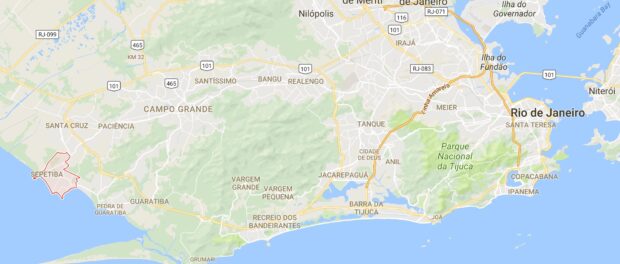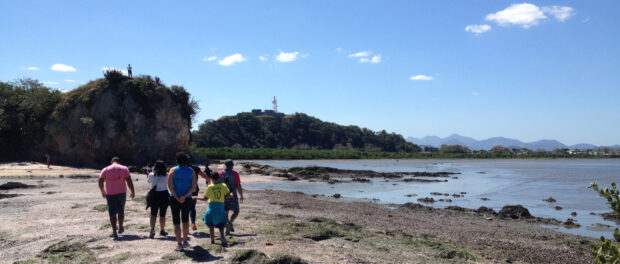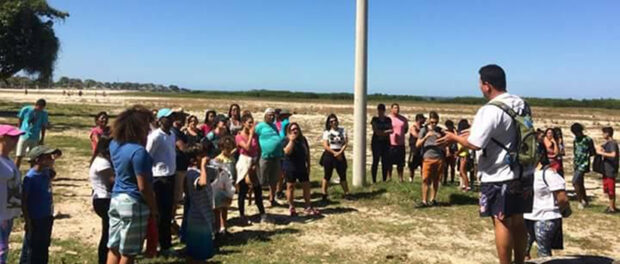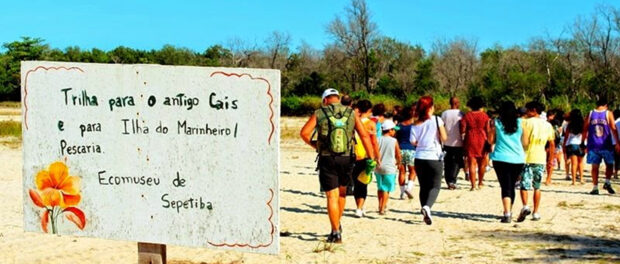
Initiative: Sepetiba Ecomuseum (Ecomuseu de Sepetiba)
Contact: Blog | Website | Facebook Profile | Email
Year Founded: 2007
Community: Sepetiba
Mission: “Research, maintain, document, decipher, value, and disseminate testimonials of man and the environment, with the objective of collaborating in the building and transmission of collective memories, and for local sustainable and itegral development.”
Public Events: Recognition and Ecotourism Tour, first Sunday of every month
How to Contribute: The Ecomuseum looks for researchers of all backgrounds to aid in their community history and ecology work. Donations of books, especially those written in braille, are requested for their community library.
Early on a warm September morning in Rio’s far West Zone neighborhood of Sepetiba, a large group of residents and visitors gathered around its historic seaside bandstand for the Sepetiba Ecomuseum’s monthly Passeio de Reconhecimento, or Tour of Recognition. Professor Luiz Bolete welcomed them with an opportunity to make their own instruments out of re-purposed plastic bottles followed by a percussion workshop. Then, the crowd swelled for an awards ceremony recognizing outstanding contributions to the community. Finally, Emerson, a local physical education teacher, led stretching and a warm-up before the tour started. Bianca Wild, founding member of the Ecomuseum and Professor of Sociology for Rio’s State Education Secretariat (SEEDUC), addressed the participants. “Those here for the first time will experience a different Sepetiba,” she said. “[The purpose of this tour] is to make Sepetiba visible and disseminate its history so as to raise residents’ self-esteem, which is a fundamental element of mobilization and struggle.”
The morning’s events and the historical-ecological tour demonstrated the type of community togetherness and pride the Sepetiba Ecomuseum hopes to promote in a community of 60,000 people that faces pollution, economic stagnation, and peripheralization. The group visited imperial ruins and indigenous archaeological sites while enjoying stunning views of the Sepetiba Bay.
“We do not have a headquarters. Our museum, our archive, our building is all of Sepetiba… It’s a museum from the bottom up,” Wild explained. As a territorial museum reflecting a type of ‘new’ or ‘social’ museology, the ecomuseum concept is to be “aware of the community with the objective of developing its territory through the valuing of its local history and patrimony, both natural and cultural,” according to the ecomuseum of neighboring Santa Cruz. Sepetiba’s Ecomuseum is one of many social museology movements happening in favelas around Rio as platforms for resistance. It seeks to uncover the relationships between its residents, history, and environment to mobilize for positive change.
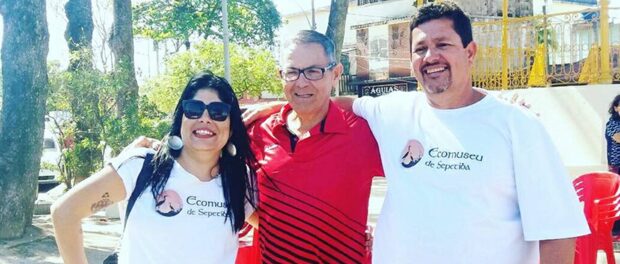
The initiatives that the group of nine Ecomuseum volunteers run in their community respond to the area’s particular needs and history. Wild explains that Sepetiba has played an important role in Brazil’s history from the pre-colonial era to the modern republic. The monthly tour visits a sambaqui, a meters tall mound of limestone and shells built by indigenous peoples thousands of years ago as places of settlement and burial grounds for their dead. Sepetiba is a Portuguese pronunciation of the indigenous Tamoio tribe’s word referring to the presence of native sapê vegetation. After colonization, Portugal’s King John VI ordered the construction of an imperial port and forts in Sepetiba, which was a summer destination for the royal family in the 19th century.
More recently in the 1970s and 80s, Sepetiba Bay attracted many visitors to its lush beaches. However, the construction of the industrial Port of Itaguaí in 1982 began a process of environmental degradation that has culminated with the controversial TKCSA steel processing plant. This pollution nearly destroyed tourism and fishing industries in Sepetiba and left many residents needing to work outside the community. Wild spoke of the Ecomuseum’s struggles to mobilize a population that travels five or more hours a day to work or to get a university education in Centro or the South Zone. She told RioOnWatch, “Being a ‘dormitory neighborhood’ of the segregated West Zone, [Sepetiba] has lives with the absence of public investment in various aspects. Many times, residents can’t participate [in our programming] because they wake up every day at 3:40am to go to work. They get back home at 11pm. They have the weekend to care for their houses and their families.”
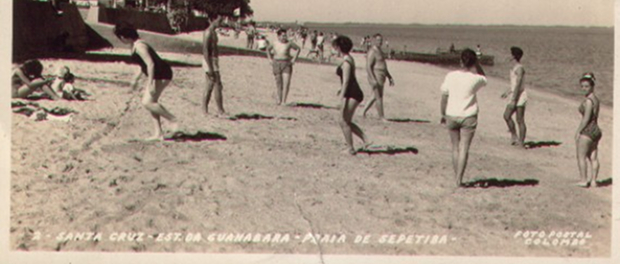
One way the Ecomuesum combats the effects of this social isolation and difficulty mobilizing residents is through patrimonial education in local schools. Students are invited on the monthly tours and the Ecomuseum provides ecological education in schools on the importance of its local mangrove ecosystems, which act as nurseries for marine life. According to Silvan Guedes, another member of the Ecomuseum team, “the schools are still coming [to our programming] a bit forced. But midway, they start to be more interested. They understand why the mud exists [washed onto Sepetiba’s shores from a destructive canal project in the 1990s], why the mangrove exists. Why we were part of the history of Brazil and why we aren’t included in the history books.”
Through these programs and the ongoing maintenance of a community library, Wild said, “we saw a change in the language used by students over these nine years now. Before we started the Ecomuseum page on Orkut [an early online social network]… the only pages we had were ‘Sepetiba of Depression,’ always denigrating the place. Now we have ‘Sepetiba that Delights Me,’ ‘Historic Neighborhood of Sepetiba,’ ‘I Love Sepetiba.’ We believe that this is thanks to our promotion of local history. We feel very proud, very happy about this.”
In addition to mobilizing local youth, the Ecomuseum has succeeded in collaborating with other organizations and researchers to develop its knowledge base about the community. Wild admitted that when the group started the Ecomuseum movement, “truthfully, we didn’t know what we were doing.” In 2007, Wild and a small group of residents began to go to the Brazilian National Archives to find more historical sources on Sepetiba, inspired by a book written by local journalist Alcebíades Francisco Rosa. In 2009, they organized a regular “memory circle” with older residents to share oral histories. When the nearby and more developed Santa Cruz Ecomuseum heard of this, the circle was included in a community museology conference, where they met Hugues de Varine, the French museologist who coined the ecomuseum concept. “Hugues said that what we were doing here was community museology. He gave a name to what we were doing. So [in 2009] we started a process of recognition initially called the Sepetiba Ecomuseum Movement,” related Wild.
Since its beginning, the Ecomuseum has participated in social museology conferences and invited distinguished guests, like Hugues de Varine and museologist Odalice Miranda Priosti, to develop its work. In 2015, Wild and archaeologist Claudio Prado de Mello successfully petitioned the municipality of Rio to protect the coastal area containing the ruins of the imperial port and a sambaqui. Providing further visibility to Sepetiba, journalist André Luis Mansur has written three volumes of West Zone history in his O Velho Oeste Carioca series. Wild said of these partnerships, “we need people that can contribute to our research. Currently, we are initiating a center of orientation and of historical, sociological, anthropological, biological, and ecological research. We need people who are willing to add, to help us understand the history of our region.”
The Ecomuseum also functions as a center for political action. During the tour, Wild and Guedes called for residents to contact them with community needs via the Ecomuseum Facebook page. Wild said, “we want to function as a channel for the entire community” to demand accountability from residents and the city government. She cited the use of the Facebook page to report someone dumping prohibited waste on the beach and as a mode of organizing to hold government agencies to their environmental promises. She described these actions as efforts to live sustainably in a community facing pollution, litter, and sedimentation along its shores. “We believe that sustainability for us is… learning to handle adversity, transforming negative into positive for the conservation of what we consider important.”
Referring to the potential to implement similar projects in other Rio communities facing precarious circumstances, Wild says that “every locality deserves a center of memory and refuge… Generally, the dominated spaces are these spaces of refuge that are the most sacred to us, the spaces where we find peace and roots. Roots are primordial so that we always have somewhere to return, so that we always have the sense to fight for what we love, for the place we know. The first thing that anyone trying to do this type of work has to do is know the place where they live, really know it. The bad things as much as the good ones. You have to understand your territory and always look for the support of all of the population.”
When asked about dreams for the future, Wild said, “I hope Sepetiba returns to being valued and having visibility… that we succeed in protecting our spaces, that we succeed in making Sepetiba an alternative historic destination in the city, that we develop community tourism here so that the population that is passing through this period of economic stagnation can have a source of income. So that one doesn’t need to relocate to Centro, Barra da Tijuca, or the South Zone to work… that these discourses of local depreciation change, and we all begin to value the entire population. That this youth, this new generation that’s taking part, succeeds in maintaining this work.”
The enthusiasm of the almost sixty Sepetiba residents who participated in the September tour was a testament to the success the Ecomuseum has had in this regard. Its motto, “a mirror in which one re-views oneself and discovers one’s own image,” speaks to how it wants to involve Sepetiba residents in taking responsibility for their community. At the end of the tour, a local student read a poem their friend had written entitled, “My Sepetiba.” The first stanza read, “Sepetiba is so beautiful, even with so much poverty / even being isolated. But we shine for sure.”
*Ecomuseu de Sepetiba is one of over 100 community projects mapped by Catalytic Communities (CatComm), the organization that publishes RioOnWatch, as part of our parallel ‘Sustainable Favela Network‘ program launched in 2017 to recognize, support, strengthen and expand on the sustainable qualities and community movements inherent to Rio de Janeiro’s favela communities.

